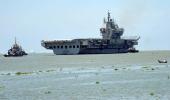London hopes to convince New Delhi's naval planners to power India's second indigenous aircraft carrier with the Queen Elizabeth's integrated all-electric propulsion system.
Ajai Shukla reports.

On Friday, October 22, a group of senior Indian Navy admirals helicoptered out from Mumbai and landed on HMS Queen Elizabeth, the Royal Navy's flagship aircraft carrier that is moored in the Arabian Sea on her way back to the UK after patrolling the South China Sea.
HMS Queen Elizabeth is named after the iconic 16th century British monarch, also called the Virgin Queen, whose legendary admiral, Sir Francis Drake, destroyed an invading Spanish armada in the summer of 1558, setting England on course to be the world’s predominant naval power for the next 350 years.
The Royal Navy is harking back to those glory days with its carrier battle group showing its teeth to China. Too small to go it alone, London has allied in the Asia-Pacific with Washington and Canberra in a grouping called Aukus (Australia-UK-US).
Its visit to India had a more prosaic purpose: London hopes to convince New Delhi's naval planners to power India's planned second indigenous aircraft carrier (IAC-2) with the HMS Queen Elizabeth's 'integrated all-electric propulsion system' that is based on two Rolls-Royce MT30 gas turbine alternators and four diesel engines.
Earlier, the Indian Navy had hoped to power IAC-2, which will be named INS Vishal, with a nuclear reactor.
A key element of the US-India defence relationship is the 'joint working group' on aircraft carrier cooperation. However, the Indian atomic establishment will take several years to deliver a reactor small and powerful enough for an aircraft carrier.
And Washington has not offered to assist with a reactor design, the way it has offered to help Australia build a line of eight nuclear-powered submarines.
London, however, is pointing out to Indian planners that nuclear power is essential only for the 100,000 tonne supercarriers that the US navy fields.
The INS Vishal is built to more modest proportions, tipping the scales at 65,000 tonnes -- exactly the same as the HMS Queen Elizabeth -- and carrying a similar aviation complement of 50-60 aircraft.
"The Queen Elizabeth already has exactly the propulsion solution that India requires for the Vishal," explained a senior British officer, talking anonymously.
"The Rolls-Royce MT30 gas turbine is the most power-dense in the world," said Kishore Jayaraman, the South Asia chief for Rolls-Royce.
Jayaraman is looking beyond the IAC-2 to India's future naval fleet, including the eponymous next-generation frigates and next-generation destroyers, which he would like powered by Rolls-Royce MT-30 turbines instead of the American LM2500 and Ukrainian Zorya gas turbines that are currently used.
Jayaraman said the Queen Elizabeth’s two MT30 turbines generate 36 megawatts each and are supplemented by four Finnish Wärtsilä diesel generators that provide another 10 Mw each.
These drive electric motors provided by US firm GE Power Conversion, which propel the carrier at 32 knots (60 km per hour).
The groundwork for UK-India defence cooperation has been gradually built up over the preceding years. New Delhi and London recently signed a Memorandum of Understanding on Defence Technology and Industrial Capability Cooperation.
This is the UK's first such inter-government arrangement, designed with India's preference for sovereign-to-sovereign transactions in mind. That was supplemented in May by a roadmap for India-UK future relations arrived at by the two prime ministers.











